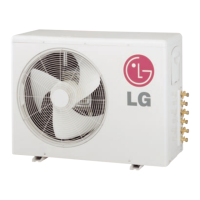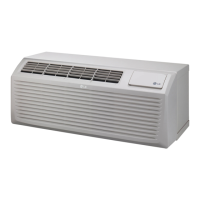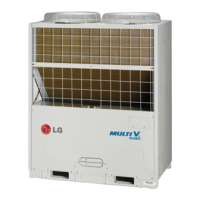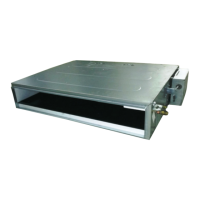Do you have a question about the LG Multi-Inverter Type and is the answer not in the manual?
Essential safety guidelines and warnings for handling the air conditioner during service.
Details on different indoor and outdoor unit models offered by LG.
Explanation of model codes and naming conventions for units.
Overview of all functions and controls available for the air conditioner.
Details on various airflow settings and modes like swing and chaos wind.
Information about the PLASMA Air Purifying System and its operation.
Settings related to unit installation, such as ESP control and high ceiling operation.
Features related to unit reliability, including self-diagnosis and hot start.
User-friendly functions like auto cleaning, sleep timer, and child lock.
Basic principles of compressor operation and RPM control.
How frequency is controlled based on room capacity and temperature settings.
Detailed explanation of the reversing valve's role in mode switching.
Control logic based on discharge pipe temperature.
Methods to control total current for protecting semiconductor devices.
Operating logic for the outdoor fan based on outdoor temperature.
Algorithm and conditions for defrost operation.
Control logic for the Liquid Expansion Valve (LEV) opening.
Operation to restore oil in the compressor after certain running times.
Logic to protect the compressor at low outdoor temperatures.
Protection logic for the power module based on heatsink temperature.
Pre-test checks including refrigerant leakage and valve status.
Step-by-step flowchart for performing the test run.
Precautions and checks for completing the test run.
How to interpret error codes and indicators for indoor and outdoor units.
Procedure for recovering refrigerant by pumping down the system.
Process for removing air and moisture from the refrigeration cycle.
Procedure for charging refrigerant into the system after evacuation.
Trouble analysis based on temperature difference and operating current.
Troubleshooting steps for product non-operation and remote controller issues.
Essential safety guidelines and warnings for handling the air conditioner during service.
Details on different indoor and outdoor unit models offered by LG.
Explanation of model codes and naming conventions for units.
Overview of all functions and controls available for the air conditioner.
Details on various airflow settings and modes like swing and chaos wind.
Information about the PLASMA Air Purifying System and its operation.
Settings related to unit installation, such as ESP control and high ceiling operation.
Features related to unit reliability, including self-diagnosis and hot start.
User-friendly functions like auto cleaning, sleep timer, and child lock.
Basic principles of compressor operation and RPM control.
How frequency is controlled based on room capacity and temperature settings.
Detailed explanation of the reversing valve's role in mode switching.
Control logic based on discharge pipe temperature.
Methods to control total current for protecting semiconductor devices.
Operating logic for the outdoor fan based on outdoor temperature.
Algorithm and conditions for defrost operation.
Control logic for the Liquid Expansion Valve (LEV) opening.
Operation to restore oil in the compressor after certain running times.
Logic to protect the compressor at low outdoor temperatures.
Protection logic for the power module based on heatsink temperature.
Pre-test checks including refrigerant leakage and valve status.
Step-by-step flowchart for performing the test run.
Precautions and checks for completing the test run.
How to interpret error codes and indicators for indoor and outdoor units.
Procedure for recovering refrigerant by pumping down the system.
Process for removing air and moisture from the refrigeration cycle.
Procedure for charging refrigerant into the system after evacuation.
Trouble analysis based on temperature difference and operating current.
Troubleshooting steps for product non-operation and remote controller issues.
| Cooling Capacity | Varies by model (typically 9, 000 - 36, 000 BTU/h) |
|---|---|
| Power Supply | 220-240V, 50/60Hz |
| Refrigerant | R32 or R410A |
| Indoor Unit Weight | Varies by model. Typically between 8-15 kg. |
| Outdoor Unit Weight | Varies by model (typically 30-50 kg) |
| Features | Inverter Technology |











